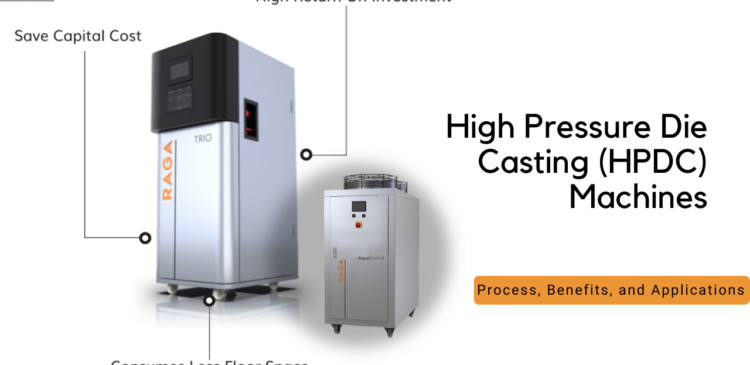High Pressure Die Casting (HPDC) Machines: Process, Benefits, and Applications

HPDC machines are at the heart of modern manufacturing, enabling the production of complex metal parts with unparalleled precision and efficiency. This technology is a cornerstone for various industries, offering significant benefits such as high production rates and exceptional dimensional accuracy.
Understanding High Pressure Die Casting (HPDC)
What is HPDC?
High Pressure Die Casting (HPDC) is a manufacturing process where molten metal is injected into a die cavity under high pressure. This method is designed to produce intricate metal parts with high precision and a flawless surface finish.
Key Components of an HPDC Machine
- Injection System: Responsible for injecting molten metal into the die.
- Die: The mold that shapes the final product.
- Plunger: Forces the molten metal into the die cavity.
- Cooling System: Ensures rapid solidification of the metal.
- Ejection Mechanism: Removes the finished part from the die.
History and Evolution of HPDC Machines
HPDC technology has come a long way since its inception in the early 20th century. Advances in materials and automation have significantly enhanced the efficiency and capabilities of HPDC machines, making them indispensable in modern manufacturing.
The HPDC Process
Step-by-Step Breakdown
- Preparation and Melting of Metal Alloys: The metal alloy is melted in a furnace.
- Injection of Molten Metal: The molten metal is injected into the die cavity under high pressure.
- Solidification and Cooling: The metal cools and solidifies within the die.
- Ejection of the Finished Part: The solidified part is ejected from the die and may undergo post-casting treatments if necessary.
Key Elements of the HPDC Machine
- Injection System: Delivers molten metal to the die.
- Die: Shapes the final part.
- Plunger: Pushes the metal into the die.
- Cooling System: Solidifies the metal quickly.
- Ejection Mechanism: Removes the finished casting from the die.
Types of HPDC Machines
Hot Chamber vs. Cold Chamber HPDC Machine
- Hot Chamber HPDC:
- Advantages: Faster cycle times, suitable for low melting point metals like zinc and magnesium.
- Disadvantages: Limited to low melting point metals.
- Cold Chamber HPDC:
- Advantages: Suitable for high melting point metals like aluminum and copper.
- Disadvantages: Slower cycle times, higher energy consumption.
Applications for Each Type
- Hot Chamber HPDC: Ideal for small, high-volume parts like consumer electronics and small automotive components.
- Cold Chamber HPDC: Best for larger parts requiring high strength and precision, such as automotive and aerospace components.
Materials Used in HPDC
Commonly Used Alloys
- Aluminum: Lightweight, strong, corrosion-resistant.
- Magnesium: Lightweight, good mechanical properties.
- Zinc: Excellent for thin-walled parts, high dimensional stability.
Selection Criteria Factors to consider when selecting materials for HPDC include melting point, mechanical properties, and the intended application of the final product.
Benefits of Using HPDC Machines
Efficiency and Speed HPDC machine offer high production rates and reduced cycle times, enabling manufacturers to produce large quantities of parts quickly.
Precision and Accuracy HPDC achieves tight tolerances and intricate details, ensuring consistency in part quality and dimensions.
Cost-Effectiveness Reduced labor costs and material wastage, along with the long-term financial benefits, make HPDC machine a cost-effective choice for large-scale production.
Applications of HPDC Machines
Industries and Sectors
- Automotive: Engine blocks, transmission cases, structural parts.
- Aerospace: Aircraft components, turbine blades.
- Consumer Electronics: Housings, connectors.
- Industrial Machinery: Various mechanical parts.
Case Studies and Success Stories Examples include lightweight aluminum engine blocks for improved fuel efficiency and high-performance aerospace components that reduce weight and enhance durability.
Challenges and Solutions in HPDC
Common Challenges
- Porosity: Presence of air pockets within the casting.
- Die Wear: Wear and tear affecting the quality of parts.
- Thermal Fatigue: Repeated heating and cooling cycles causing die degradation.
Solutions and Best Practices
- Minimizing Defects: Optimizing injection speed and pressure, using high-quality materials, and ensuring proper die design.
- Innovations: Advancements in die materials and coatings to enhance die life and reduce defects.
Conclusion
High Pressure Die Casting (HPDC) machines are essential in modern manufacturing, offering the ability to produce complex, high-quality metal parts efficiently. As technology advances, HPDC will continue to play a pivotal role in various industries, driving innovation and enhancing product quality.
FAQs
-
What is High Pressure Die Casting (HPDC)?
High Pressure Die Casting (HPDC) is a manufacturing process where molten metal is injected into a die cavity under high pressure to produce complex metal parts with high precision and excellent surface finish.
-
How does HPDC differ from other die casting methods?
HPDC uses high pressure to force molten metal into the die cavity, while other methods like low-pressure die casting use gravity or vacuum to fill the die. HPDC is suitable for metals with high melting points, such as aluminum and magnesium.
-
What are the advantages of using HPDC machines?
HPDC machines offer high production rates, excellent dimensional accuracy, and the ability to produce complex shapes with thin walls and intricate details. They are also cost-effective for large-scale production.
-
What are the main applications of HPDC machines?
HPDC machines are widely used in the automotive, aerospace, electronics, and consumer goods industries to produce components like engine blocks, transmission cases, and housing parts.
-
What are the challenges associated with HPDC?
Challenges include managing porosity, die wear, and thermal fatigue. Proper mold design, control of injection parameters, and regular maintenance are essential to address these issues.
-
How can porosity be minimized in HPDC?
Porosity can be minimized by optimizing the injection speed and pressure, using high-quality materials, and ensuring proper venting and cooling of the die.
-
What are the future trends in HPDC technology?
Future trends include advancements in automation, improved control systems, and the development of new materials and alloys to enhance the performance and efficiency of HPDC machines.
